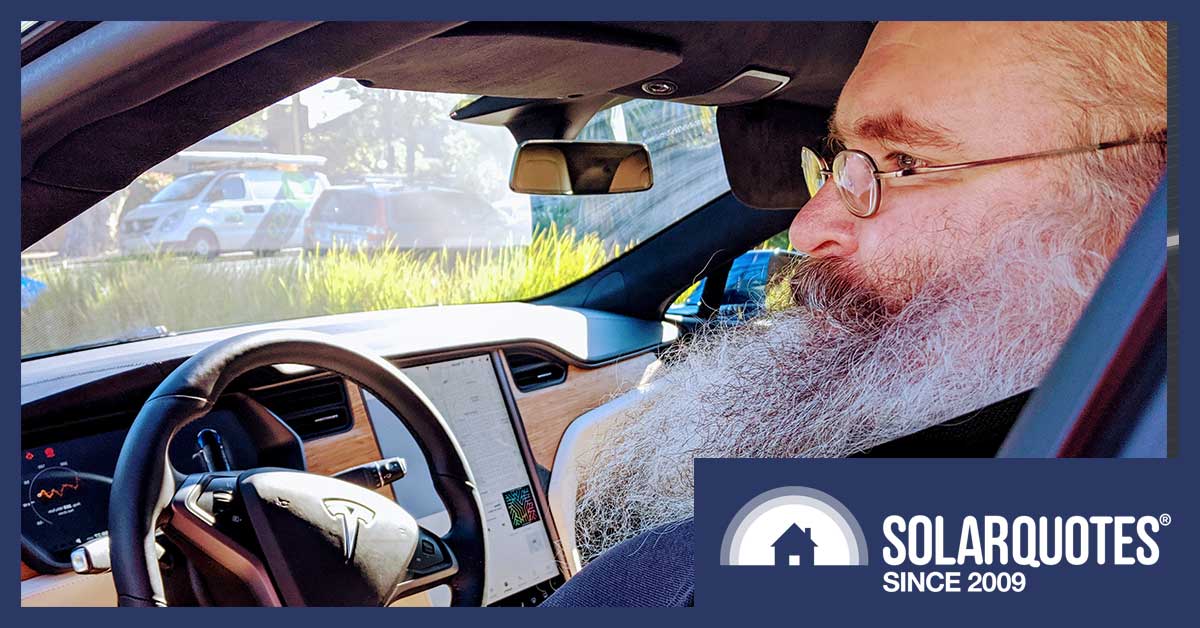
Hold on to your beards! Ronald’s spent the weekend in a brand new 2019 Tesla Model S. Here’s what happened…
Allow me to transport some information to your eyes that is simply electrifying. Finn, my boss, has bought a Tesla Model S electric sports car. It is AWESOME. I know this because he let me drive it for two days. This joy ride convinced me the Tesla Model S is the best car in the world. I’ll even go further and say that — with the information I currently have at hand — it is the best car in the universe.
Its performance is flabbergasting, with acceleration so rapid it will be at least a least a week before my flabber catches up with me. No petrol burning car in its price range comes anywhere close. Revheads reading this may be able to name million dollar internal combustion cars that do better, but those don’t emit zero emissions from the vehicle or have the option of running completely off clean renewable energy, including solar power from your own panels.
It is, by far, the best car I have ever driven and there is one thing I am absolutely sure of — with a starting price of $149,000 it’s definitely not worth it. Not for me. It was fun to drive but not over $100,000 worth of fun. I could get an awful lot of enjoyment out of 100 grand. I would use it to swim with hotels and stay in fancy dolphins.
But your mileage may vary. If you already spend this kind of money on cars I’m certain you’re doing yourself a disservice if you don’t get a Tesla. And if you normally spend much more than this on cars, then get a Tesla Model S anyway. You’ll probably like it and if you don’t a moneybags like you hasn’t really lost anything. (If you don’t like it, just give it to me and I promise you’ll never see it again.)
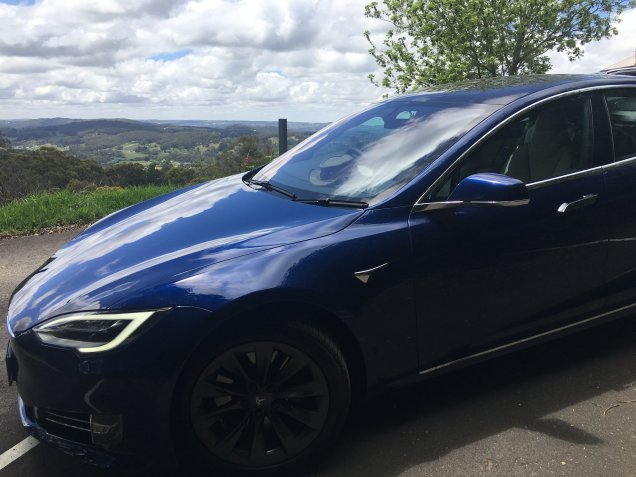
Driving a $150,000 sports car made me feel as though I was normally physically endowed. So around three inches taller.
You Can’t Trust Tesla
I was going to tell you driving the Model S has convinced me to buy one of Tesla’s lower cost cars. Maybe the Model 3 when it falls in price or possibly the still under development Model Y that should be even cheaper. But then I checked the Tesla website and was instantly reminded of the kind of company they are and came crashing back down to earth.
The site is deceptive and I’m pretty confident it breaks Australian consumer law. So while I can recommend their product to anyone in the market for a luxury car, I can’t recommend the company. I wouldn’t leave Tesla alone with my grandmother because I don’t trust them not to sell her something she either doesn’t want or doesn’t need. If you deal with Tesla you always need to double check what they say or imply is actually true.
Remember, just because they’re not lying capitalist pigs making money from destroying the planet doesn’t mean they’re not lying capitalist pigs. But then lying communist pigs produce sports cars like the 2-stroke Melkus RS 1000, so it could be worse.
But enough depressing talk about Tesla’s perfidy. Let me instead tell you how awesome their Tesla Model S electric car is!
Finn Is Way Too Trusting
Finn is very environmentally aware and so he’s eager to convince people to make the change to electric cars. As a result, all I had to say to convince him to lend me his Tesla was:
“In all my years of driving I’ve never had an accident or a ticket.”
And it worked! A more suspicious person might have asked:
“But how many accidents did you directly cause?”
Or possibly:
“Exactly how many years have you been driving? Is it more than zero?”
But he didn’t ask and all I can say is thank god for trust. It lets me get away with so much! I was surprised it worked since I had previously let it slip I only see in two dimensions and didn’t know humans were supposed to see in 3D before I saw Avatar.1
Tesla has reduced the number of variants of the Model S so now there are only two types available in Australia:
- The Model S Long Range version with a starting price of around $149,000.
- The Model S Performance version with a starting price of around $174,000.
Finn got the Standard Range version that Tesla discontinued just after he placed his order. The Standard Range has a 75 kilowatt-hour battery instead of a 100 kilowatt-hours, which is the only size available now.2 Then he blew a big chunk of those savings away by paying for some “special features” such as the actual colour he wanted3 as well as $8,500 for the very incorrectly named, “Full Self-Driving Capability”.
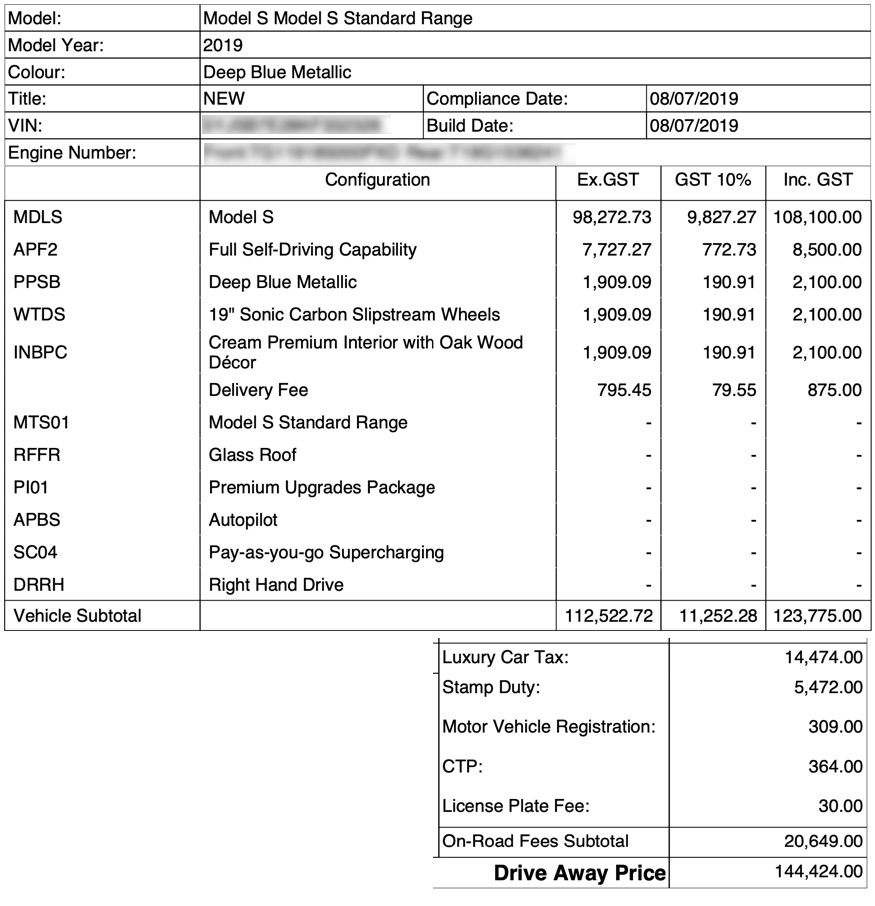
The invoice from Tesla Australia for the (now discontinued) Model S Standard Range.
So Much Acceleration!
At 8:20 on a beautiful Sunday morning Finn handed over the plastic doodad that can let you hop in and drive off without worrying about keys, although Finn has activated an extra safety feature where you need to enter a code number as well. (He was very clever as he chose 1368 — the number of watts of sunshine energy per square meter at the top of the atmosphere. No one will ever guess that!) Then I picked up my son…
…and Sam, my lives-a-bit-too-far-away-to-be-a-neighbour and went for a spin.
I tried to resist at first, but it wasn’t long before I gave in to temptation and used more than just mild pressure on the accelerator:
RONALD: Tell me what you think of the acceleration. (Applies modest pressure to accelerator pedal.)
SAM: GWARRRRRRRRRRRRAAAAAAAAAAAAAHHHHHHHHHHHHHHH! It’s… It’s good.
RONALD: Only good? Let’s try that again.
SAM: GWARRRRRRRRRRRRAAAAAAAAAAAAAHHHHHHHHHHHHHHH! I knew it was coming, but I can’t stop making that sound!
RONALD’S SON: Dad, was everything supposed to go dark except for a small circle in front of me where all the colour shifted to a blue haze?
RONALD: That’s just the blood pooling in the back of your brain. As you get older and start running low on blood you’ll see like that all the time.
SAM: That’s not a normal part of aging. That’s called tunnel vision and you shouldn’t be driving if you have it. GWARRRRRRRRRRRRAAAAAAAAAAAAAHHHHHHHHHHHHHHH!
RONALD’S SON: I think I want to get out of the car now.
RONALD: Well, I’m not stopping, so you’re only allowed to jump out if we pass a hospital.
After subjecting my passengers to several dozen more bursts of insane acceleration, we stopped in the German-themed hamlet of Hahndorf to recover with some beer, but since I was driving a $150,000 car I drank hardly any litres at all.

His mother doesn’t let him drink, so my son has to do some catching up when he’s with me. But don’t worry, I teach him to drink responsibly. He has to finish all his beer before getting another one.
The non-performance Tesla Model S can go from 0 to 100 kilometres an hour in 3.8 seconds. This understates how well it accelerates in normal use around town because, thanks to the way electric motors work, the 0 to 50 time is under half that. So whenever I wanted to merge into traffic and was wondering if a gap was large enough, the answer was always yes. Maybe if I drove the Tesla long enough my perception of what counts as a gap would change and the answer wouldn’t always be yes, but that would take some time. (In the interest of science I’m willing to see just how long it will take if someone wants to lend me their Tesla.)
The Model S battery is built into the floor and weighs 590 kilograms, giving a low centre of gravity. With its all-wheel drive each tyre felt as though it was stuck to the road with an entire horse race worth of glue. I felt more road traction stomping on the Tesla’s accelerator in the wet than when I’m parking my Hyundai.
The Performance version of the Tesla Model S goes from 0 to 100 in 2.6 seconds. If you put the pedal to the metal it will accelerate faster than my Hyundai would if I drove it off a cliff. That’s equal to the best a cheetah can manage and for a greyhound to beat that you’d have to glue two of them together. It’s simply ludicrous.
Going For Speed
Both versions of the Tesla Model S have a top speed of 250 kilometers an hour. So I’ve been told. I don’t know because I didn’t go that fast. It was easy to accidentally exceed the speed limit, but not that easy. I only intentionally exceeded the speed limit one time and that was when I was overtaking. All I know is the acceleration showed no sign of tapering off. With the maximum legal speed being 130 kilometers an hour in the Northern Territory, the Tesla Model S’s top speed is irrelevant to Australians unless you have a racetrack handy.
Going For Distance
The thing people people are usually most worried about when it comes to electric cars — range — is not an issue. Unless you’re a traveling salesperson or something, the problem is fixed if you drive a Tesla.
When fully charged the Tesla Model S Long Range version can travel around 560 kilometers.4 I didn’t have enough time to determine if this figure is spot on, but apparently it’s what the average driver gets.5 That’s roughly 7 hours normal highway driving for me, although it might only be four and a half hours if you’re doing 130 on a Northern Territory highway. In 15 years I’ve only taken my Hyundai Getz on two trips where that involved driving more than 7 hours a day. And sitting behind the wheel that long is not something I recommend. Over seven hours is too long on the road for a single driver.
But if you do want to drive more than 560 or so kilometers, Tesla has you covered. Or they do in the majority of places people actually want to go. This is because they have installed a heap of electric car chargers around the place that come in two main types:
- Destination Chargers: These can take over an hour to provide 100 km range.
- Superchargers: These can take less than a dozen minutes to provide 100 km of range.
Tesla is also bringing out ultrachargers that are even faster than superchargers. There is also a third type of slow Tesla charger, which I’ll tell you about it in a bit.
Destination Chargers
Here is the Destination Charger I briefly used at the Fox Winery:
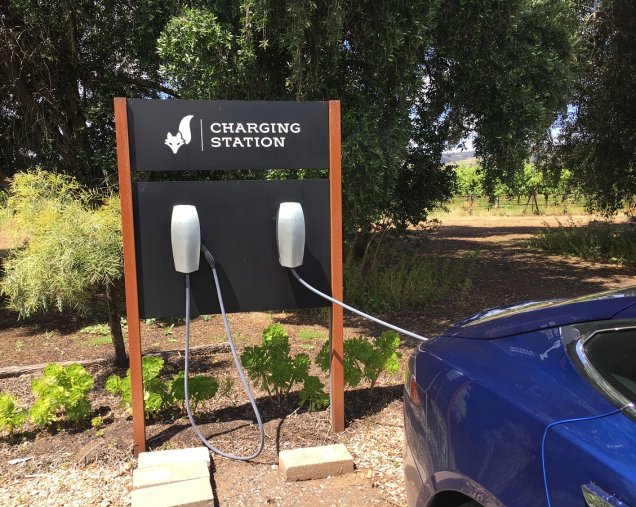
The Fox Winery Tesla Destination Charger. I was surprised when they told me it received a fair bit of use.
And here is the Tesla Model S display showing the car charging from it:
If shows the destination charger would provide 93 kilometers of range per hour of charging. It would take hours to fully charge a mostly flat battery pack, but for topping up while relaxing it’s very convenient. The exact rate will depend on how much charge is already in the battery. Like a mobile phone it will be moderately faster when nearly empty and moderately slower when nearly full.
Note: You need to check your charging cable is pushed all the way in. I discovered power can flow at lower rate when it isn’t. I doubt it was dangerous, but the fact this is possible in the Model S surprised me.
The location of Destination Chargers can be found online. There’s a considerable number scattered around. There wasn’t one shown online for the McCracken Country Club6 where I spent Sunday night, so I was surprised to see what looked like one as I drove up. I plugged the Tesla in and came back when I thought it would be nearly fully charged. The car told me there were still nine and a half hours to go.
The reason why it wasn’t listed online was obviously because it’s not fast enough. The lesson is — just because it looks like a destination charger, it isn’t necessarily one. But if you are staying overnight a slow charger like this is likely to be all you need. The wonderful receptionist there told me she’d never seen anyone else use it before, so get your Tesla down to the Country Club and goddamn stay there for at least nine hours.7
Tesla Destination Chargers and slow chargers are free to use. Tesla will pay for their installation but the location pays for the electricity. This is fine for businesses trying to attract customers, but I do wonder about the morality of Councils installing them, since most Tesla drivers are rich and shouldn’t need to be subsidized by common folk. But, given the harm vehicle pollution causes, it may be worthwhile. And when you get down to it, isn’t that what society is all about? Bribing the rich not to hurt us?
Tesla Supercharging
Here is the Tesla Model S connected to the Supercharger in the centre of Adelaide:
And here is the display showing it charging furiously:
The Supercharger is zapping the Tesla full of 510 km worth of range every hour. In under 12 minutes it will be able to drive an additional 100 km.
There aren’t a huge number of superchargers in Australia at the moment, but there are enough so you can exclusively use them to drive from Adelaide to the Sunshine coast north of Brisbane. Generally, you will have to pay to use them, but I didn’t bother to look into the costs because I figure if you can afford a Tesla you can bloody well afford the supercharger fees.
Charging In a Pinch
If you have the right connector you can charge the Model S at any public electric car charger, although you’ll also need the right app or credit card or whatever they require. You can also charge from a normal power point or a 15 amp socket such as those found in caravan parks. Note you’ll only get about 12 kilometers of range per hour from a normal power point.
Problem Solved
You could still claim a Supercharger isn’t nearly as good as a petrol pump that can slosh a car full of 500 km of range in just minutes. But, overall, most people will spend less time fueling a Tesla than a petrol or diesel car. This is because when Finn gets home he just plugs in his home charger, which takes seconds, and it automatically tops up his car with surplus solar electricity. The only time he ever has to do anything more is if he’s taking a long trip. But a typical driver has to spend at least 10 minutes a week going to a service station, which comes to about 9 hours a year. Finn will spend less than an hour annually plugging and unplugging his Tesla and then maybe a few more hours on long trips using a supercharger or topping up with a destination charger when he would be relaxing anyway. So, when you add it all up, he’s coming out ahead on time.
Note: I’m not talking to the person who is going to turn up in the comments and tell us how charging an electric vehicle will never work for them because of their particular circumstances. That’s fine! They can buy a hybrid! I’m talking about normal people. The average person is going to spend less time charging an electric car than they currently spend putting petrol in their tank.
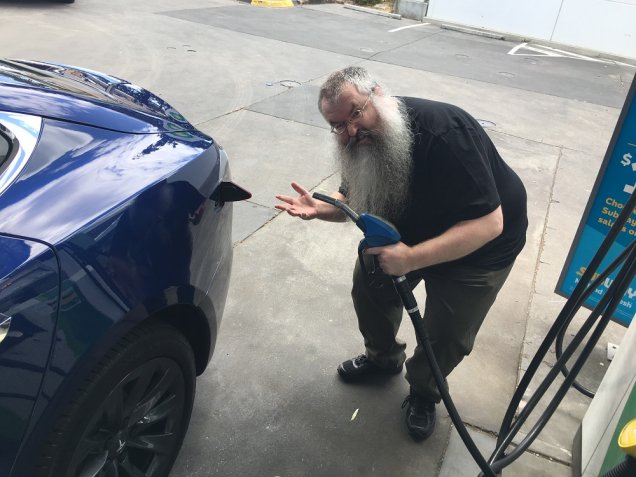
“Master, how can I fuel your Tesla? The holes are too small!” I couldn’t find where to put the petrol in Finn’s electric car. Luckily, I found a large empty space under the bonnet call a “frunk” which could hold plenty.
Comfort
The Tesla Model S is the worst car I have ever driven when it come to climbing in and out. I was surprised. It’s a large car, but it’s a lot easier to jump in and out of my little Hyundai Getz. Someone like my father could never use a Tesla Model S on account of his bad back. Not unless they make one that rises up off its wheels.
But this is a normal problem for sports cars. They’re designed for movie stars and models, not massively overweight people like me.8 If you want the stupid high speed that goes with low aerodynamic drag, then a low roof is a necessity.
My friend Sam is 190 cm (six foot three) and while he didn’t feel cramped, I’m not sure he would have fit if he was much taller. Both of us had trouble getting the buckles of our seat belts in and his belly is considerably smaller than my own. (Obviously, he hasn’t hasn’t developed his stomach muscles as much as I have.)
Once you’re actually in the car and buckled up it’s fine. But I have to admit I’m not a great judge of comfort. After all, I do find Finn’s taste in music to be bearable.

I went to Victor Harbor. (How lucky were they that Victor’s last name just happened to be Harbor?) There’s an island you can walk to, so I had to explore it. It was in Encounter Bay so not exploring the island would be like not wanting to level up at all.
Brakes? Who Needs Brakes?
Normally when you take your foot off the accelerator a car it will start to slow down. When you take your foot off a Tesla’s accelerator it will slow considerably more. This is intentional and makes driving easier because you only need to brake when something unexpected happens. It’s also a little bit of a safety feature, as the car will already be de-accelerating in the time it takes to transfer your foot from the accelerator to the brake. It may seem strange when you’re reading about it, but it all feels natural when you try it.
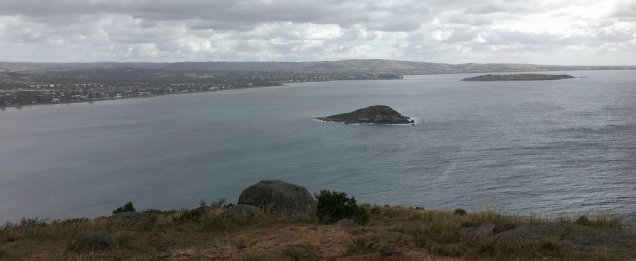
I took this photo next to a plaque that said at this spot Matthew Flinders Frenched in 1802.
A Big Display
The Tesla Model S has a large touchscreen that handles everything that isn’t vital. This includes music, navigation, and a billion other things I didn’t bother checking.
This was the first time I had used car navigation with a screen large enough to actually see what was going on. I had heard this can make your ability to navigate without it worse and it’s true. The map rotates to the direction you’re traveling so north doesn’t stay at the top and this fried my ability to orientate myself. Lately, I’ve been trying to use the North Queensland trick of always using a compass direction instead of left and right to improve my sense of direction and the car navigation system blew all that hard work away.
The Model S screen turns into a big rear view display when the car is put into reverse, which is very useful. At first I had trouble believing what the screen showed me was “real”, but it didn’t take long to get used to it.
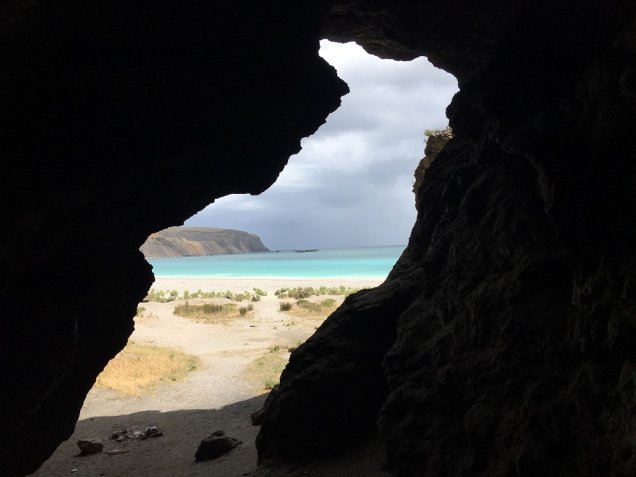
When I was locked in Plato’s Cave I had trouble knowing if the shadows on the wall were real. Mind you, Uncle Plato was a bit weird. Other people called the shadows on the wall television.
Voice Activation
If you hit a button on the steering wheel you can tell the car what to do, such as display navigation or play music. For these two things it works pretty well, unless you go out of mobile phone reception range, in which case it understands English about as well as your deaf Croatian Aunt after she decides to make your life hell for not marrying a nice Croatian girl.9
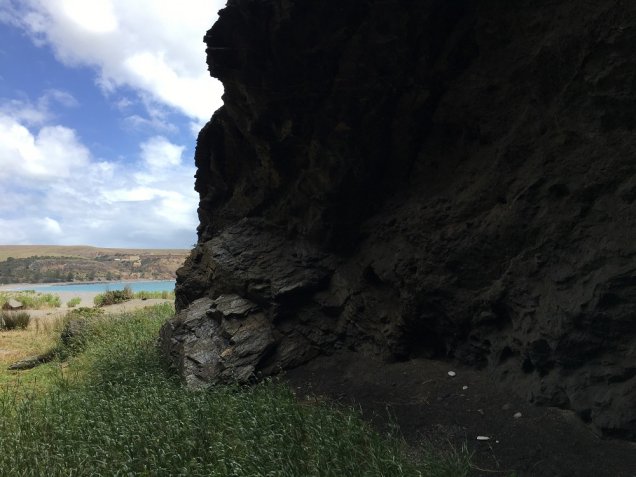
Photos these days have way too much subject matter.
Robodriving
Finn paid extra so his Tesla would have “Full Self Driving Capability”, which is named about as accurately as the Democratic Republic of the Congo. It can’t self-drive and it will be the Department of Transport and Main Roads that decides if it will ever be allowed to do that, not Tesla.
But it’s still pretty funky.
My understanding is every Tesla Model S has cruise control, can steer itself to stay in its lane, and warns you if you come too close to an obstacle.
If you spent the extra $8,500 the package of lies costs, then — depending on whether or not it feels like it — the Tesla Model S can do automatic lane changes, park and unpark itself, and stop you from doing something stupid like sideswiping a truck.10 In the future — according to Tesla — it will be capable of driving itself. But they’ve already been sued for lying about what it would be able to do, so don’t believe what Tesla tells you and understand that you’re just throwing the dice when you pay for this.
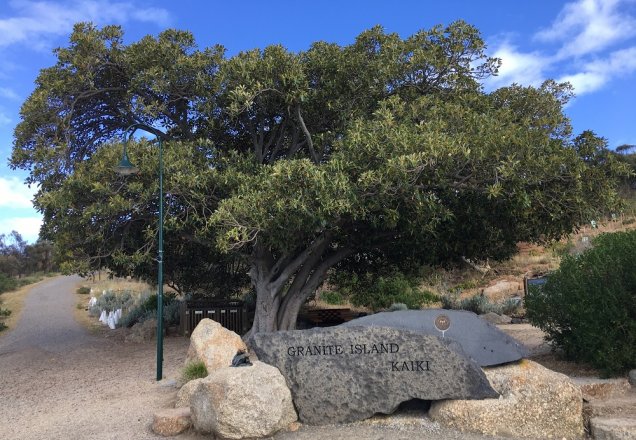
I thought the Kaiki was a lie because it was as hard as rock, but it turns out it’s actually the name of the Island and not meant to be the Japanese pronunciation of the word “cake”.
I tried the cruise control and the lane keeping and I gave up on them because they were just too stressful to use. I was worried I’d stop paying attention to the road and have a prang. In Japan they fully understand this problem and make their train drivers constantly do a little dance to keep them alert. But there wasn’t much room for dancing in the Tesla Model S, so I was scared I’d space out. I’m fine with the fact there are no gears to change, but cruise control and lane keeping seem to make it too easy to fall asleep at the wheel. However, I know some people like these features and they’re not dead yet, so each to their own.
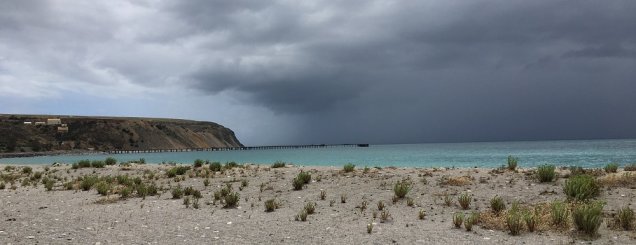
“I watch the lightning crack over Rapid Bay, and laugh and think, this is Australia.”
It’s Oh So Quiet!
When I first started driving the Tesla Model S, I didn’t realize how quiet it was because I was feeling super stressed about driving a $150,000 car.
It didn’t really sink in until I turned on the stereo and thought there was something wrong with the speakers. It took me a while to figure it out, but I realized the problem was I could actually understand the lyrics to the song. I had never been able to do this before with my usual driving music. It turned out, much to my surprise, that at no point is Meatloaf saying…
“Like a cattle bell I’ll be corn when the morning gongs.”
I never realized Meatloaf was using language before. I thought he just had some kind of musical word salad brain injury.
Because I have highly refined and sophisticated musical taste, I think it might be worth $10 an hour for me to be able to appreciate the more subtle aspects of music, such as lyrics, when driving. If I drove an average of an hour a day then an electric car would provide me with around $3,652.50 a year in enhanced musical pleasure.11 This is one aspect of electric vehicles I’ve never really considered.
It’s also a lot easier to have a conversation. When I had passengers I could clearly hear everyone in the vehicle, including my son in the backseat. None of us were “autoshouting” which is the mode of communication we unconsciously slip into when inside an internal combustion engine car.
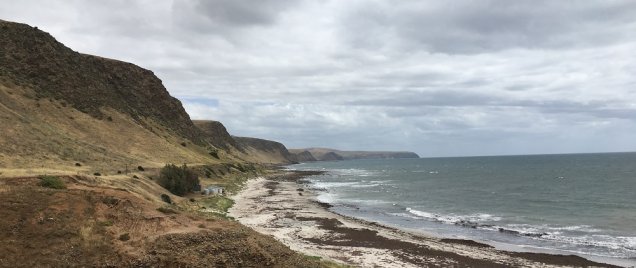
If the SA Tourism Board doesn’t send me a check I will be very upset.
Best Tesla Model S Music
Here are some of the best tracks to listen to in a Tesla Model S. Finn might add a few of his own, but don’t trust him. My picks are far superior:
Harder, Better, Faster by Daft Punk
Tell Laura I love her by Ray Peterson.
Back in Bow River by Cold Chisel
I Regret Nothing by Dead French Chick
Finn’s Selections:
Here Comes the Hotstepper by Ini Kamoze
I Like to Move It by Reel 2 Reel
Around the World in a Melkus Communist Sports Car by ATC
Enhanced Sexiness Quotient
Now we get to the real information you’re all hanging out for that the other car reviewers just won’t reveal. Exactly how sexy does driving a Tesla Model S make you?
I’ll put some figures to this by telling you how many sexy men and sexy women approached me over a two day period of driving it:
- Sexy Men ?
- Sexy Women 1.5
I don’t know how many sexy men approached me because I can’t tell if they’re sexy or not. If you’re a dude and you ask me how sexy you are I’m just going to base it on how much you look like a woman.
You may think 1.5 is a low figure for the number of sexy women, but I’ve adjusted it to allow for my natural background sexiness. I know this adjustment reduces the figure’s reliability, but it’s not my fault I’m god’s gift to women. (And feminine looking men.)
But because a German woman I spoke to about the car was so sexy I’m going to have to adjust the figure upwards by at least an order of magnitude and boost it to 15. So by my calculations I would say driving a Tesla Model S will roughly double the sexiness of the average human being, while having little or no effect on someone who is already as sexy as myself — if such a person exists.12
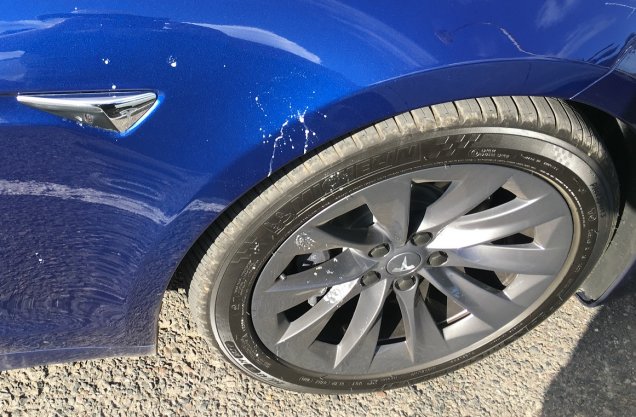
“HOLY SHIT!” or if caused by a bird rather than a passing incontinent angel, “MUNDANE SHIT!” (Thank god I noticed this and cleaned it off so Finn will never know about it.)
A Glorious Driving Experience
I really glad I got the opportunity to drive a Tesla Model S. It was a lot of fun.
Unfortunately, the fun doesn’t last for that long.
When I started driving the Tesla at 8:20 in the morning, at first I couldn’t stop cackling like a maniac every time I put my foot down on the accelerator. But, at exactly 1:25 pm, I did stop. I tried cackling like a sane person for a while, but sane people are horrible at cackling, so that wasn’t nearly as much fun.
It’s a great car but the amount of mad cackling enjoyment you’ll get out of it just isn’t worth the expense. Even if — unlike me — it significantly boosts your sexiness, in the long run paying for a lot of alcohol is going to be a cheaper option. (Either for yourself or your date. It works both ways.) The Tesla 3 starts at $73,000 so if you get that instead, you’ll have a Tesla car plus at least $75,000 left over. Invest that in the share market and with the return you can spend an average of $6,000 on fun every year for the rest of your life.13 Or you could just buy a bicycle, save almost all the money, and instead of becoming sexier via association with a metal shell, your own body would become sexier from the exercise.14
When Finn said he was getting a Tesla I just assume he meant a Tesla 3 because I couldn’t see how the extra expense of the Tesla Model S would ever pay for itself, even if it is superior to every other car on the road. In all the time I’ve known him, I’ve only once seen him waste money on something that had no hope of ever paying for itself. And when I got into his Tesla it was like he was getting a package deal.
Footnotes
- I have two eyes, and I see in two dimensions. Surely that’s enough! If we were supposed to see in 3D, god would have given us 3 eyes! At least it has the advantage I’ll never need to spend extra money on a fancy TV like you 3D seeing freaks. ↩
- What he may actually have is a 100 kilowatt-hour battery that has been factory locked to 75 kilowatt-hours. If that’s the case, that was pretty lucky, as only using it to a maximum of three-quarters of its full capacity will slow the rate it deteriorates and he could potentially pay to have the battery unlocked if he wanted the extra range. Or he could unlock it himself as it is his car and he can do what he wants with it. (But they’d probably be a bit cranky with him if he did that.) ↩
- That was dumb. My friends, Pigdog and Spider, could have spray painted his Tesla Model S any colour for a fraction of the cost. And it would be guaranteed for 3 months or until it rains. ↩
- Finn’s Tesla has a 100 kilowatt-hour battery pack that has been locked to 75 kilowatt-hours. But because the only Tesla Model S battery size now available is a full 100 kilowatt-hours I’ve given the approximate range for the full size one. ↩
- According to the Tesla Model S readouts of my energy use, I would actually get 588 kilometers range from a full charge. And according to Finn’s data he’d only get 550 km. But then Finns are known for driving like maniacs. Or it might be because I mostly drove on the highway while he does more driving in town. ↩
- I chose to stay here because there’s a large solar power system on the roof. ↩
- Update 12th November 2019: The McCracken Country Club has told me their Tesla Charger apparently needs to be tweaked so it will start working like a standard destination charger. Once that’s done it will charge much faster and will presumably start showing up online when searching for Tesla destination chargers. ↩
- Massively overweight due to my muscularity, of course. ↩
- To be fair, marrying a horrible Croatian girl probably wasn’t the smartest move you’ve ever made. ↩
- So I’ve been told. I wouldn’t actually know anything about that myself. ↩
- Actually, my musical taste isn’t really that refined. I just pretend it is to impress women and it would really only be worth about $487.26 to me. ↩
- Apart from the German woman, of course. ↩
- You may have to pay some tax on that, but not as much as if you got it from working. ↩
- That is, sexier to those who aren’t sensible women who prefer “real” men. ↩

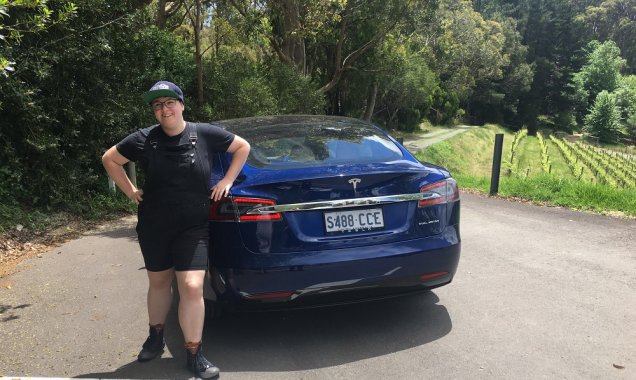
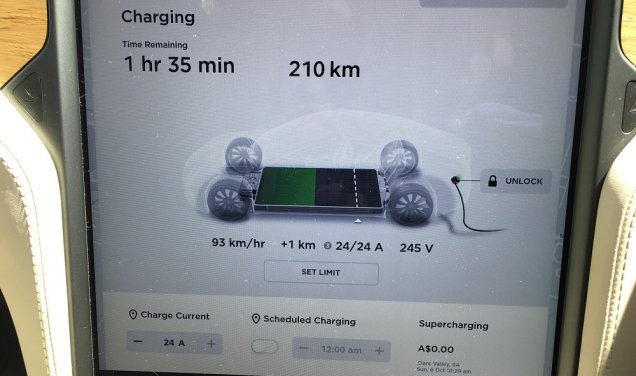
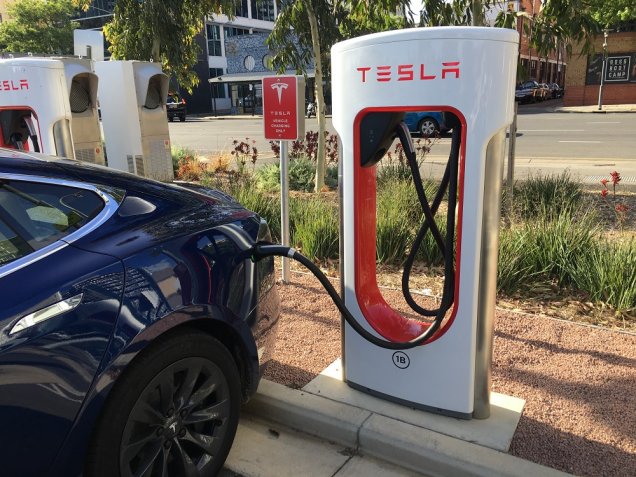
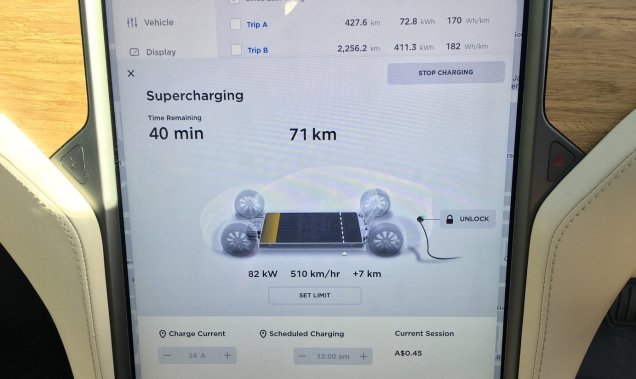
 RSS - Posts
RSS - Posts



We will have 4 of the Tesla Cars on Display at the Mawson Lakes Tindo Solar factory tomorrow 12/11/2019.
The one with the uplifting gold-wing style doors, perfect for hiring for weddings,
Uhhh, Falcon wings, maybe? Some Mercs have Gullwing doors…
Oh dear, those gull wing doors never fit properly due to the complicated hinges which have several pivots in them each of which have some backlash. The commonest problem with them is paint scrubbing off the rubber pads on the bottom of the doors meet the back wheel arch when they’re closed. That paint scrubbing generally starts on day 2 of ownership. See Rich Rebuilds’ youtube channel for more details!
I wish the Regen at 0 throttle position could be disabled. It makes it so much easier to drive more efficiently. Maybe that’s a hangover from the range anxiety days
“According to the Tesla Model S readouts of my energy use, I would actually get 588 kilometers range from a full charge. And according to Finn’s data he’d only get 550 km. But then Finns are known for driving like maniacs. Or it might be because I mostly drove on the highway while he does more driving in town. ↩”
Actually Ron, the reverse is true. At highway speeds EVs are much less efficient. So yes, Finn does drive like a maniac.
As far as the “full self driving option” option goes what are Tesla supposed to call it? I think you’re right that regulators won’t approve it any time soon. I think the consumer just has to weigh up whether it’s worth the extra money. It wouldn’t be for me for precisely the reasons stated in your article, but I don’t think it’s deceptive. There is a disclaimer on their website and a list of what it actually includes and what is planned. It’s not in small type either like most vehicle manufacturers.
I wondered about the efficiency difference between town and highway driving for the Tesla S and it turns out it is pretty close with about 10% more consumption on the highway compared to town according to the US EPA. Given the way I actually drove and allowing for things such as air conditioner and other loads, Finn has an out if he wants to deny driving like a maniac. But yeah… I’d would put my money on him being a maniac behind the wheel.
As for what they should call their “Full self driving option” well, Tesla has to pay me a consultancy fee if they want me to apply my brainpower to their marketing. ($20 an hour: Genius doesn’t come cheap.) But to avoid running foul of Australian Consumer Law they should have called it something like “Incomplete self driving option”.
Yep they lie and the issue a disclaimer. It might work in the USA but here in Aussie they might find themselves in hot water.
I cannot believe you left “Hotrod Lincoln” off your playlist!
I can’t believe I left off “Transfusion”:
“Or you could just buy a bicycle, save almost all the money, and instead of becoming sexier via association with a metal shell, your own body would become sexier from the exercise…”
Or you could bike eBikes… as we did. Weight has dropped from 97.6 kg to 81.4kg… and I’ve covered 1998 kms exactly (mostly at 26 kph… when no battery power is consumed… )
Amusing article… the most comprehensive (and different) review of the Tesla S I’ve read.
While Toyota and Mercedes engineers recently laughed at the possibility of fully-autonomous cars* let’s remember that Musk has achieved every one of his goals over time. OK, Mars may be a decade away, but when you have a spare hour, list his achievements sometime. Yes, I’m a Tesla shareholder. My kids bought me a share for Christmas. 🙂
*Fully-autonomous means, of course, any road of any surface, anywhere, in snow, heavy rain, fog, cyclone, bushfire smoke, etc., etc.. But this fella lands space ships on barges in the ocean… and then re-uses them. (Much easier, sez my missus!)
I guess you think the hyperloop is a success.
And,. that his rockets don’t fall off his barges when folk aren’t looking.
And that his underground car tunnels are destined to replace our roads….
Does the RAA now have to have a mobile battery or solar panels or generator to recharge these cars when people inevitably get it wrong ?
Well, the RAA already have flat bed trucks so if someone ignores the warnings (Teslas tell you if you are about to go out of range of charging points) then it can be loaded onto one of them and taken to a charger. But as long as you bring the adapter with you, then every power point becomes a service station. Admittedly a very slow one.
In the US they apparently do have trucks with generators for people let their car batteries go flat on them. But I presume they service all electric cars.
Technically pushing or towing could allow a car to charge using their regenerative braking, but I don’t think Tesla is down with that.
Personally, when I’m in an electric car and the battery is running low, I just drive in reverse for a while until it has a decent charge again.
Just when I thought I’d read all the Tesla articles I needed this was so honest and refreshing. Great sense of humour. Keep on writing, about anything.
brilliant, a car that recharges from a coal fired power station, maybe gas in SA, but in most states of Australia. Finn, I am aware you have a roof full of panels and at lest a couple of batteries to charge from, you are the exception, yes your exceptional, I’m talking about the other 399 teslas in Australia. People seem to think these things run on Fairy dust, not dirty old coal, give petrol a go.
In this article I go into how a fuel efficient hybrid will produce around two-thirds the greenhouse gas emissions of an electric car that is charged from the grid per kilometer:
https://www.solarquotes.com.au/blog/electric-cars-environment-kelly/
Hopefully, it won’t be long before out grid is clean enough so electric cars clearly beat hybrids. But they still result in less CO2 emissions than a conventional petrol powered car per kilometer driven and are far better from a health perspective since cars release pollution at ground level where people work and live.
For an electric car to be really green about 2 kilowatts of additional solar PV capacity has to be installed to provide clean energy.
Great article, but so many questions.
What about servicing? What’s involved, how often, what does it cost, who does it? Do you just call in your local sparky?
Technically electric cars need very little servicing. In practice Tesla expects you to pay them for servicing. I would have looked into how much it costs, but since my recommendation is to not get one unless you are really rich anyway and already spend around that much on new cars I didn’t bother. If someone lends me a Tesla Model 3 or other electric car to review I’d probably look into it then as it’s more within the reach of the merely very well off rather than the very rich.
I suspect electric car manufacturers will soon start selling electric cars with free multi year servicing built into the price since, in practice, the cost of servicing is so low. On the other hand, servicing is how dealerships rip off — I mean, legally extract consumer surplus from customers, so established car manufacturers may find this difficult to do.
One thing I would check is how much the internet connection costs. Around $5-6 a month sounds reasonable to me, but I suspect it will actually be a lot more for a Tesla S.
The Tesla Model 3 (I have one so know it better than a Model S) has no service schedule at the moment, the Adelaide techs even said so. Washer fluid and maybe eventualy brake fluid, but you won’t liekly ever need new brake pads unless you race it.
That sounds promising. One of my concerns was that servicing would be used to extract money from EV owners, who would be likely to just follow whatever schedule the manufacturer sets as that’s what they’ve been trained to do by internal combustion vehicles.
Provided there are reliable sensors I presume the vehicle could simply state when you are running low on wiper fluid or need to top up brake fluid.
Ronald,
I’m wondering what would require regular servicing and replacement for BEVs? These are some things that would probably need to be checked:
• Windscreen washer fluid – you could probably check and top-up that yourself.
• Windscreen wiper blade inserts – perhaps tricky for some people to replace, but a local mechanic could easily do that.
• Cabin air filters – recommended to replace every 2 years.
• Tyres – frequency dependent on how exuberant you drive, but I suspect it could be done at a regular tyre shop for tyre rotation, re-balancing and replacement.
• Brake pads – perhaps never if you don’t drive like a maniac that brakes hard at every turn and stop.
• Wheel alignment – tyre shop?
• Brake fluid change – once every 2 to 3 years?
• Differential oil change – sealed for life or does it require change after so many 100,000 km – perhaps someone knows?
See: https://www.tesla.com/en_AU/support/car-maintenance?redirect=no
This statement from the Tesla website on warranty:
“Your New Vehicle Limited Warranty or Used Vehicle Limited Warranty will not be affected if recommended service is not performed. Servicing your Tesla is required for the duration of your Resale Value Guarantee contract.”
Geez you should at least spell check your headings. I’m sure you meant:
Brakels? Who needs Brakels?
Sexy German women.
Terrific article. I laughed out loud a number of times.
Thanks!
Superbly written – have shared
Considering we are being constantly reminded that solar batteries don’t pay for themselves I’d love to see a Ronald Brakels calculation of when Finn will break even on his purchase and it will start paying for itself in terms of petrol savings. My money is on that it won’t before the batteries need replacing.
As I made clear in the article, I don’t think the Tesla S will ever pay for itself. It’s a pretty pricey machine.
Finn’s Powerwall 2 saves him less than $1 a day on his electricity bills, so that’s not going to pay for itself, but electric car battery packs superior ability to pay for themselves is pretty straight forward. An EV battery pack now typically havs a warranty period of 8 years. In the case of the Tesla S it’s unlimited kilometers. So I think it’s a pretty safe bet to assume they’ll last at least 10 years and 150,000 kilometers. Today it costs the average passenger car about $20,000 worth of petrol to drive that far. But when charged from the grid it will only cost an electric car around about $9,000. Less if rooftop solar and/or off-peak electricity is used. Tesla and Volvo say they are currently paying around $150 per kilowatt-hour for battery cells. So right now a 60 kilowatt-hour battery pack might be close to having a marginal cost of $12,000 at the moment. This is probably going to be considerably less in 10 years time. On top of that there are the advantages that, unlike home batteries at the moment, electric cars reduce greenhouse gas emissions and also greatly reduce the health effects of pollution since they aren’t blowing it out of exhaust pipes where people work and live.
So basically it comes down to: Petrol is expensive, in fuel cost per kilometer, health costs, and environmental damage. Even if people only feel the first effect on their wallets it’s likely to be enough.
Of course, given the current cost of battery cells per kilowatt-hour, the cost of home energy storage has the potential to fall a long way.
You censored my post ?
No, but I [REDACTED] this one.
Thanks for the breakdown costs and apologies Ronald. I had posted some time earlier so thought I had suffered from a Solar Quota !
No problem. I read almost every comment before it’s approved and some days I am more diligent than others.
Ronald,
Ronald, you really need to be much kinder to Finn… As you know, the water levels in the aquifers below Adelaide have dropped by quite a few metres already, and emptying more every day due to prolonged drought effects.
Now imagine… you stroll out from work to drive home one afternoon… only to find that due to an unexpected ground subsidence, all that can now be seen of your conveniently parked vehicle is the rear boot and the back passenger doors standing almost vertically in the air, with the remaining 2/3rds at risk of plunging even deeper into the newly formed subsidence crater.
Here is photo which will give you some idea of what that looks like….
https://www.telegraph.co.uk/content/dam/news/2016/05/12/97662597_A_car_which_has_partially_disappeared_down_a_sinkhole_in_Woodland_Terrace_in_Greenwich_sout_trans_NvBQzQNjv4BqT1CHodmL3LaIfnPoainGNAb643Od-MrFK7Cuixbkngg.jpg?imwidth=1240
So please, show Finn some sympathy. The growing realisation of the terrible mistake he’s made in foolishly discarding his energy efficient bicycle and in a moment of mad impulse, purchasing the Tesla S ( ‘S’ as in ‘sinkable’ ) is steadily beginning to hit home.
Oh my goodness! This is why I drive a little Hyundai Getz. So when things like this happen I can just pick it up and put it somewhere safe.
But don’t worry, Finn hasn’t abandoned his bicycle. I’m pretty sure he’d try to cycle with both legs in casts.
No -if you look closely at the car, it is the front end of the car pointing upward and toward the intersection. The driver clearly made a wrong turn, went down the wrong rabbit hole, but, eventually found the way back to the right street, and, is simply driving back out of the rabbit hole, onto the street.
I think it needs to be an all-wheel drive, or a four wheel drive, using low ratio, to get back up onto the street…
Interesting and amusing review, thank you, but really a weekend is not long enough to appreciate how extraordinary these cars really are. We’ve just returned from a six month 32,000km road trip in a Tesla S85D circumnavigation of North America, from LA up to Alaska, across Canada to possibly the world’s most remote Tesla charger on Fogo Island off Newfoundland, down the east coast and the Outer Banks, and back via the Gulf Coast through Texas, the Grand Canyon and Route 66 to LA.
We bought the 2016 car with a range of 420km direct from Tesla who needed a bit of convincing they could sell a car to an Australian with no US licence. It came with free supercharging and a 4 year/50,000mi warranty both of which were freely transferable to the new owner when we sold it for what we’d paid for it at the end of the trip. Apart from insurance ($700 for 6 months with proof of our Aus driving record) and sales tax/rego fees the total fuel, repair and maintenance costs for the entire journey were just US$5.75, (no, that’s not a misprint). For that kings ransom we drove the most innovative and fastest car we’re ever likely to own through some of the most amazing places on the planet. In doing so we creating zero direct emissions and total emissions including those from electricity generation and the car’s manufacture of less than half the equivalent journey in an ICE SUV.
About 70% of the trip was driven on autopilot and although it doesn’t perform everywhere coped with winding mountain roads as easily as freeways, provided there was some distinguishable centre or edge line. It was far more attentive than any human driver, spotting and responding to obstacles, other vehicles and speed limit changes, even temporary and mobile ones (eg on the back of a grass cutting tractor), and automatically knowing whether ’50’ meant km/hr (Canada) or mi/hr (USA). As long as we kept a hand lightly on the wheel every minute or so we could gaze at the scenery or spot wildlife or read the map
Space doesn’t allow me to tell you about its reindeer or cozy log fire modes, or its netflix although these were a boon when riding out Hurricane Dorian in Nova Scotia. Ours didn’t perform well tho’ as a chick magnet but there were lots of interesting conversations when charging, particularly when we picked up an escort of 130 Teslas to drive down the Blue Ridge Parkway in N Carolina. (When was the last time you struck up a conversation at a petrol station with a sculptor and were invited to dinner? Tesla owners are a hospitable bunch)
Range anxiety is a thing of the past in the US where you are rarely more than 100mi from a supercharger, but Canada like Australia has a Great Electron Desert, spanning thousands of kms from Calgary to Ontario and into the maritime provinces and from Whistler to the North Pole. Trip planning becomes an art but there are plenty of free Level 2 ie 7-10 hour chargers at hotels, national parks, museums etc and when the worst comes to the worst every house is a fuel station, although at 110v you may wear out your welcome well before you’ve fully charged.
Apart from the ludicrous acceleration – yes everything ends up in the back seat as you pass a road train, and the reindeer, – the other fun thing is getting into your car in a morning and discovering the new tricks it’s learned overnight when, like an iphone on wheels, it’s had one of its frequent software upgrades. We had to restrain ours from trying to show off its new parallel and perpendicular parking skills, or its ability to drive itself out of a garage.
With several years lead on Australia there are plenty of used Teslas for sale in the US, sold thru Tesla, at prices rather more reasonable than those here. Our 2016 model was almost $100k cheaper than a new one here, and with free repairs and maintenance – actually you don’t have any routine maintenance on a Tesla apart from tyres, cabin air filter and wiper blades, as they only have about a dozen moving parts – and a design life of 500,000 to 1 million miles (that maybe only for the one Elon sent into space) there’s little risk in buying a 2nd hand one.
So yes, we’ve been drinking the KoolAid and brainwashed by the teslarati, but as soon as Finn wants to sell his for $50k in 3 years time we’ll be first in the queue. Unless of course in the interim our leaders have started to provide the sorts of incentives which have driven the take up of EVs in the rest of the world. I’m not sure which is the more likely but I suspect we may have to coax more polluting miles out of our old ICE for a few years yet.
Until electric cars become sufficiently advanced, to have manual floorshift transmissions, I think one of the last years of availability of the Land Rover Defender – the 2015 or 2016 model (not the upcoming, new, plastic 2020 model that does not even look like a Defender) would be a better investment of the $150,000, and would be more fun to drive, and, safer, and, a more desirable car for we lesser well-off to dream of. After all, drivers are going to more carefully avoid crashing into a rock (a real Land Rover Defender), than a plastic toy sportscar (the tassler ). And, the last real Land Rover Defenders have a 6-speed floorshift manual transmission.
There’s no need for gears thanks to the way electric motors work. In Australia you’re just not allowed to go fast enough for it to make a real difference, although I suppose arguably they could benefit from having one (additional) gear. The Tesla Roadster did have a gear, but that was abandoned for the Tesla S.
One aspect that has occurred to me, regarding the naterial above – with this 150,000AUD car, with its 100kWh battery, what is the warranted battery life, and, the round trip efficiency of the battery, and, the depth of discharge, and, thence, what is the Levelised Cost per Warranted KiloWatt Hour of the battery?
And, is the battery replaceable, and, if so, for what cost? From what I understand, with some electric cars, over the last couple of years, the batteries have not been replaceable, so that, after 100,000km or whatever, the car needs replacing.
Thus, apart from these aspects, what is the expected lifetime of the car?
As an analogy, from what I understand, Land Rovers are quite happily motoring on, along with other cars from the time of the first Land Rovers, some seventy-odd years later.
Are these 150,000AUD cars expected to last more than ten years and 200,000km?
Or, are they just Austentayshus showpieces and status symbols, of the wealthy upper class?
Bret Busby in Western Australia,
You state:
“From what I understand, with some electric cars, over the last couple of years, the batteries have not been replaceable, so that, after 100,000km or whatever,”the car needs replacing.”
That may be so … for now.
Elon Musk promised Tesla would soon have a million-mile battery, more than double what drivers can expect today. A new paper suggests he wasn’t exaggerating. A Wired article dated 23 Sep 2019 includes:
“Earlier this month, a group of battery researchers at Dalhousie University, which has an exclusive agreement with Tesla, published a paper in The Journal of the Electrochemical Society describing a lithium-ion battery that “should be able to power an electric vehicle for over 1 million miles” while losing less than 10 percent of its energy capacity during its lifetime.”
See: https://www.wired.com/story/tesla-may-soon-have-a-battery-that-can-last-a-million-miles/
1,000,000 US miles =1,609,344 km
So, how long do you think a vehicle with a 1.6 million km life would last you?
You also state:
“As an analogy, from what I understand, Land Rovers are quite happily motoring on, along with other cars from the time of the first Land Rovers, some seventy-odd years later.”
Sure – so long as they have the appropriate, affordable and adequate amount of hydrocarbon liquid fuels available to operate with. But will hydrocarbon liquid fuels remain abundant and affordable into the 2020s and beyond? Some indicators I see suggest perhaps not.
See: https://www.solarquotes.com.au/blog/australia-fuel-economy-worse/#comment-516813
Also: https://www.solarquotes.com.au/blog/australia-fuel-economy-worse/#comment-533403
Perhaps ICEVs will become historical relics in the not too distant future for lack of an affordable fuel supply?
You forget that Land Rovers have always had a need of highly trained repairers over the years, from neanderthals with stone axes to three degree university qualified instruction followers cabable of attaching a label “return to manufacturer for diagnosis”.
Regarding my last post, I do not know what distance your Getz has travelled, Ronald, but, ours has passed 196,000km, and, is about 13 years old.
I wonder whether one of these 150,000AUD Tesla things, will make the distance.
Ronald did qualify his observations right from his choice of headline “…totally not worth it” so I don’t think he is recommending anyone purchase this vehicle at all, unless they have as much money as Finn (:D) in which case the cost/benefit calcuation goes right out the window. (Teslas do still have windows, right?)
Apropos this excellent observation by Robert Massaioli a few years back
https://medium.com/@robertmassaioli/tesla-and-horses-what-did-people-actually-say-3c53169d9bc
Bret
With respect there are quite a few Tesla S’s that have done well over 200,000 miles in the US , still on original batteries (hire cars).
Tesla Youtubers that use their model 3’s for business travel have run up over 40,000 miles with only a 3% drop in range, note the drop is intial and it has tended to suffer no observable degradation since – it is in the proprietary battery formulation and battery management.
https://www.youtube.com/watch?v=z4m1sS5dmWE
A Youtuber 12 Wing Productions who is a production Engineer with decades of high level experience has been looking at the new battery chem, the Maxwell acquisition and Hibar acquisition and puts together an excellent case that next years battery investor day will reveal a solid state battery with a million mile range that will be lighter and cheaper and with a higher charge discharge rate
Bret Busby in Western Australia,
You state:
“…ours has passed 196,000km, and, is about 13 years old.”
So that works out (for you) at roughly 15,000 km on average traveled per year – you appear to be slightly above the national average.
Per ABS stats for Australian motor vehicle use, for the 12 months ending 30 June 2018:
“• There were an estimated 19 million motor vehicles
• In total these vehicles travelled an estimated 255,031 million kilometres at an average of 13.4 thousand kilometres per vehicle”
See: https://www.abs.gov.au/ausstats/[email protected]/mf/9208.0
Per this post, dated 19 Jun 2019:
https://www.earthava.com/how-long-does-a-tesla-battery-last/
“After 160,000 miles, the battery operates at a 90% capacity.”
160,000 US miles = 257,495 km
If you travel 15,000 km per annum, then it would take 17.2 years before the battery capacity drops below 90%. Do you really think you should be worried that these “Tesla things” won’t make the distance? I wonder how many ICEVs would last that distance without a substantial refurbishment?
If the battery could do 500,000 US miles (or 804,672 km), and Elon Musk appears confident that could be the case soon, before dropping below 90% capacity, then @ 15,000 km/y it would take 53.6 years. Are you worrying about nothing?
Ronald speaks of difficulty in getting in and out of the Tesla, perhaps he should have a test drive of the X model which is an SUV format. Very easy to get into and out. When I enquired about service costs Tesla in Qld where quoting around the $800 – $900 per year, with the service required once a year.
In the first picture the car looks left hand driving…
Looks like the photo has been flipped. Either that, or I didn’t notice the steering wheel was on the wrong side.
Well, I take both options into account 🙂